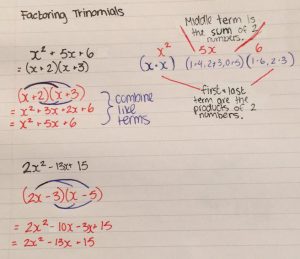To find the X intercept you make Y equal to 0. Essentially you want to isolate X in order to find what it is equal to. When  finding the Y intercept it is nearly the same thing except you replace X with 0 in order to isolate Y to find what it is equal to.
finding the Y intercept it is nearly the same thing except you replace X with 0 in order to isolate Y to find what it is equal to.
When you write the X intercept in ordered pair form you but the X value first followed by Y (which should be 0).
ie: (-4, 0)
Same with if you’re writing out the Y intercept in ordered pair form, you put the Value as 0 and plug in the Y value.
ie: (0, 13)
When you have these two points you can begin to place them on a graph.
 decreases from right to left. (M) is the variable for slope and rise is (X) and run is (Y)
decreases from right to left. (M) is the variable for slope and rise is (X) and run is (Y)
 finding the Y intercept it is nearly the same thing except you replace X with 0 in order to isolate Y to find what it is equal to.
finding the Y intercept it is nearly the same thing except you replace X with 0 in order to isolate Y to find what it is equal to. I chose to go over the distributive property because I forgot about this unit when going over the review package as well as the numbers unit. In distributive property you multiply the constant by the contents inside the brackets. Make sure your work is neat and tidy so you don’t get lost in bigger equations. I like to colour coordinate my terms so Its easier for me to decipher which terms I can group and which I cannot.
I chose to go over the distributive property because I forgot about this unit when going over the review package as well as the numbers unit. In distributive property you multiply the constant by the contents inside the brackets. Make sure your work is neat and tidy so you don’t get lost in bigger equations. I like to colour coordinate my terms so Its easier for me to decipher which terms I can group and which I cannot.
 The first thing you want to do when removing the GCF in a trinomial is find all the factors of each number. Each number that has similar factors you can begin to remove, you want to place the factor you chose and move it outside of the brackets as well as dividing that number out of the trinomial, the number you get from dividing the factor goes inside the brackets. This makes factoring much easier. I chose simple examples which in my first example my numbers were 5, 15, and 10 and the factor I removed and divided by was 5x because in the trinomial each number had (X) in it. In my second example I had numbers 6, 9, and 18 and I removed 3 and divided each number by 3.
The first thing you want to do when removing the GCF in a trinomial is find all the factors of each number. Each number that has similar factors you can begin to remove, you want to place the factor you chose and move it outside of the brackets as well as dividing that number out of the trinomial, the number you get from dividing the factor goes inside the brackets. This makes factoring much easier. I chose simple examples which in my first example my numbers were 5, 15, and 10 and the factor I removed and divided by was 5x because in the trinomial each number had (X) in it. In my second example I had numbers 6, 9, and 18 and I removed 3 and divided each number by 3.
 In this lesson of polynomials we learned how to FOIL. Its a method used when multiplying using the distributive property that is very easy and the way you write it out makes it very easy to understand when looking at it rather than trying to do it in your head.
In this lesson of polynomials we learned how to FOIL. Its a method used when multiplying using the distributive property that is very easy and the way you write it out makes it very easy to understand when looking at it rather than trying to do it in your head.

 The measurement unit for me was a little difficult as there us so many units to convert and its a long process going from a bigger unit to smaller ones or switching metric to imperial or vice-versa. I found this unit very easy to make a little mistake on. the imperial system in mainly used in the US but we still use certain measurements like when we when we use our height or weight.
The measurement unit for me was a little difficult as there us so many units to convert and its a long process going from a bigger unit to smaller ones or switching metric to imperial or vice-versa. I found this unit very easy to make a little mistake on. the imperial system in mainly used in the US but we still use certain measurements like when we when we use our height or weight.